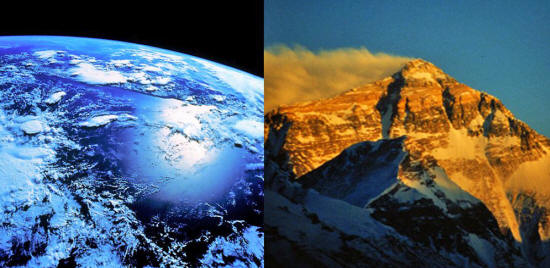|

October 09, 2016
from
MessageToEagle Website

Scientists at the University of Chicago have discovered a very large
part of our planet's continental crust that was there 60 million
years ago is missing from the Earth's surface.
Three geoscientists examined the
collision of Eurasia and India, which began about 40 to 60 million
years ago.
During the collisions the Himalayas were
created and the process is still in slow progress.

The Himalayas
Using cutting-edge computational software, the scientists computed
with unprecedented precision the amount of landmass, or "continental
crust," before and after the collision.
The results were truly surprising.
"What we found is that half of the
mass that was there 60 million years ago is missing from the
earth's surface today," said Miquela Ingalls, a graduate student
in geophysical sciences who led the project as part of her
doctoral work.
The loss of so much mass could be
possible if the missing chunk had gone back down into the Earth's
mantle...
However, from a scientific point of
view there are problems with this theory and the researchers
considered it more or less impossible on such a scale.

When tectonic plates come together, something has to give.
According to
plate tectonic theory, the surface
of the Earth comprises a mosaic of about a dozen rigid plates in
relative motion.
These plates move atop the upper mantle, and plates topped with
thicker, more buoyant continental crust ride higher than those
topped with thinner oceanic crust. Oceanic crust can dip and slide
into the mantle, where it eventually mixes together with the mantle
material.
But continental crust like that involved
in the Eurasia-India collision is less dense, and geologists have
long believed that when it meets the mantle, it is pushed back up
like a beach ball in water, never mixing back in.
"We're taught in Geology 101 that
continental crust is buoyant and can't descend into the mantle,"
Ingalls said.
The new results throw that idea out the
window.
"We really have significant amounts
of crust that have disappeared from the crustal reservoir, and
the only place that it can go is into the mantle," said David
Rowley, a professor in geophysical sciences who is one of
Ingalls' advisors and a collaborator on the project.
"It used to be thought that the mantle and the crust interacted
only in a relatively minor way. This work suggests that, at
least in certain circumstances, that's not true."
So what happened to the missing
continental crust?
In their study (Large-scale
Subduction of Continental Crust implied by India-Asia Mass-Balance
Calculation) published by Nature Geoscience the
researchers explain there were only a few places for the displaced
crust to go after the collision.
After ruling every single other possibility out, they concluded that
half of the continental crust involved in this colossal crash must
have sunk down into the hellish depths and recycled.

Some of the crust was thrust upward, forming the Himalayas, some was
eroded and deposited as enormous sedimentary deposits in the oceans,
and some was squeezed out the sides of the colliding plates, forming
Southeast Asia.
"The implication of our work is
that, if we're seeing the India-Asia collision system as an
ongoing process over Earth's history, there has been a
continuous mixing of the continental crustal elements back into
the mantle," said David Rowley, a professor in geophysical
sciences.
"And they can then be re-extracted
and seen in some of those volcanic materials that come out of
the mantle today."
|





